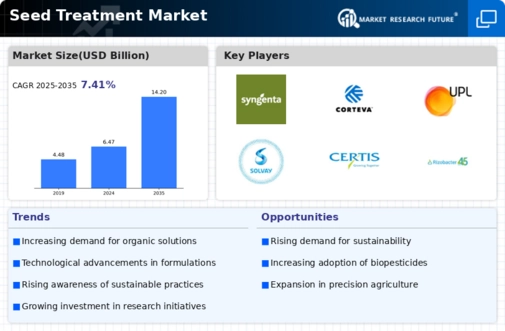Market Analysis
In-depth Analysis of Seed Treatment Market Industry Landscape
Several important market drivers define seed treatment market size and influence in the agriculture sector. Global demand for higher agricultural production to feed a rising population drives this industry.Focus on crop protection and enhanced yields drive seed treatment industry growth.
Environmental factors can influence seed treatment market dynamics. Awareness of the environmental impact of old chemical treatments is driving a global transition toward more sustainable and ecologically friendly agriculture. Seed treatment reduces the demand for broad-spectrum chemicals by targeting crop protection. This fits with sustainable agriculture, which is driving farmers and stakeholders to use seed treatment methods.
Seed treatment market size is affected by government agrochemical restrictions. Seed treatment options that meet agrochemical safety and environmental criteria are needed. Testing for new agrochemicals is rigorous, and seed treatment procedures that fulfill regulatory standards become popular. The regulatory landscape guides the seed treatment sector as it seeks effective and compliant solutions for contemporary agriculture.
Economic conditions and farmer choices drive the seed treatment business. Seed treatments' economic benefits are becoming more apparent to farmers. Seed treatment boosts crop establishment and production by preserving seeds from early challenges and promoting germination. Seed treatments are essential to modern agriculture due to their ability to boost yield and quality. Therefore, farmers are increasingly using seed treatments in their planting routines.
Recent agricultural and seed treatment formulation innovations also affect the seed treatment business. Seed treatment technologies are being developed to improve efficacy and sustainability. The market grows due to seed coating innovations such bio-based and biodegradable coatings. Advanced seed treatment formulations combined with precision farming procedures make these technologies more appealing to farmers who want to optimize their planting operations.
By 2030, the worldwide seed treatment market is predicted to reach USD 9.7 billion, growing 8.5% from 2022 to 2030. Before planting, biological, physical, and chemical substances improve crop health and reduce soil and seed-borne illnesses. The therapy boosts germination and production.
The most popular seed pesticides are neonicotinoids, especially Imidacloprid, which suppress aphids, leafhoppers, hessian flies, and chinch bugs. More efficient and less labor-intensive than spraying, seed treatment is a cost-effective crop protection strategy.












Leave a Comment